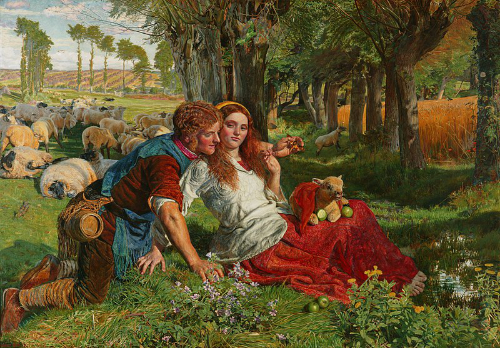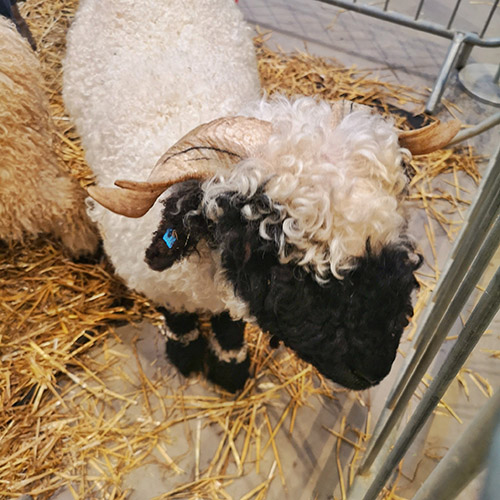Following on from 2024’s theme of the Folklore of Animals, this month we’ll examine the Folklore of Agricultural Animals. This week, we’ll explore the folklore, legends, and even folk medicine associated with sheep.
Sheep are not native to the UK. Neolithic settlers brought them to Britain from southwest Asia in around 3000 BCE. Sheepskin and other wool textiles appear in the archaeological record from the Bronze Age in northern Europe (Ryder 1964: 1).
Following the Norman Conquest, sheep became the dominant form of livestock. They primarily provided milk, with meat, wool, and manure being secondary products. By the medieval era, the focus switched to wool (Ryder 1964: 6). Unsurprisingly, they appear in folklore through tales of sheep-stealing, but also fables, like the wolf in sheep’s clothing.
Sheep appear in mythology too. The golden ram, Aries, who saved Phrixus and Helle from their evil stepmother, went on to both provide the famous Golden Fleece of Greek myth, and the Aries constellation.
But let’s take a look at some of the legends and lore associated with sheep.
The Herdwick Origin Story
Herdwick sheep are a famous breed found in the Lake District. They even have their own origin story, found near the village of Drigg. In the legend, storms drove the Spanish Armada around the western coast of mainland Britain. A galleon wrecked on the shore near Drigg and forty sheep escaped. After they swam to shore, the lord of the manor claimed them as flotsam and jetsam. It was these sheep, so says the legend, that became the ancestors of the Herdwick breed.
A different version claims it a was a Norse ship, not a Spanish one.

Beatrix Potter even drew on both versions for her 1929 book, The Fairy Caravan. A sheep explains that the breed “had ridged the slopes before the passing Romans”, and that “fresh blood came from Iceland, Spain or Scotland” (Westwood 2005: 131). Potter went on to become the president-elect of the Herdwick Sheep-Breeders’ Association.
Nowadays, they’re a common sight in the Lake District, and their fleece makes an excellent yarn choice. Interestingly, their wool takes longer to get wet and dries out faster! (Robson 2009)
Sheep Stealing Doesn’t Pay
A tale in the Denham Tracts proves why crime doesn’t pay, and took place in Catton, Allendale up in Northumberland.
A particular sheep thief lived in the area and plagued the farmers with his light-fingered ways around their flock. Try as they might to discover his identity, the farmers were none the wiser who to suspect.
Eventually, his own methods proved his undoing. He stole the sheep by tying their legs together, and then poking his head between the feet and body. Once secured, he’d carry the sheep away on his shoulders. Clearly, he could only steal one at a time, but I’d imagine that made his work easier to hide.
But on his last trip to a neighbour, he stole a sheep that was heavier than usual. He balanced the sheep on a stone pillar to take some of the weight, but didn’t take it off his shoulders. The sheep, no doubt unnerved at being balanced on the pillar, decided to struggle. It slid off the stone, and the rope around its feet dug under the thief’s jaw. The locals found him the next day, strangled by his own rope (Westwood 2005: 553). What became of the sheep is unknown.
Is it a true story?
It’s likely the tale is more of a legend than based in fact because it also appears across 25 other sites in England and Wales (Grinsell 1985: 217). A similar tale, featuring a deer rather than a sheep, appears in Leicestershire. And of course, there is the version in which a bodysnatcher’s booty strangles him over a cemetery wall in Sunderland!
Perhaps the story was a warning that stealing would never end well. Leslie Grinsell points out that sheep stealing had long been punishable by death due to the importance of sheep farming to the economy. Despite that, judges often commuted the death sentence to transportation (which in itself could be a death sentence). Between 1825 and 1831, 1039 death sentences out of 9316 were for sheep stealing (Grinsell 1985: 217).
Sheepskin Remedies
According to an Old French collection known as the Gospelles of Dystaues, or The Distaff Gospels, sheep could effect a smallpox cure. If a woman caught smallpox, her husband needed to buy her a black lamb, and bind her in its skin. Once he’d done this, he made a pilgrimage to St Radegund, where he made offerings. With any luck, she would heal (Opie 2005: 348). St Radegund was a Thuringian princess and Frankish queen. She founded the Abbey of the Holy Cross at Poitiers and she cared for the sick there, with some considering her a gifted healer (McNamara 1992: 70).

Some belief in the curative properties of sheepskin persisted. An early 19th-century remedy claimed that wrapping a naked person in sheepskin still warm from being removed from the animal would cure lameness. Even in 1912 in Herefordshire, a child was placed inside a warm sheepskin to try to cure an adder bite (Opie 2005: 348).
Applying Sheep to Body Parts
By the 1860s, the remedy evolved to putting parts of the sheep on the soles of the feet. In Leicestershire, one remedy claimed putting “a sheep’s melt” on the soles of the feet would cure anything. Meanwhile, in Huntingdonshire, putting “the skirt” of a sheep on the soles of the feet cured typhus. I’ve Googled everywhere and I cannot find what either of these refer to, so if you know, let me know below in the comments!
A belief from Abergavenny specified sheep’s lights tied to the feet to cure pneumonia. Lights are lungs, and the grandmother who practiced the cure said holes appeared in the lights as the inflammation reduced. According to whoever collected the folklore, that did indeed happen (Opie 2005: 348). It does make me wonder if these ‘melts’ were likewise offal.
In the 1890s, an Outer Hebrides remedy saw a black sheep put over painful joints to help ease rheumatism. By this point, the sheep was still alive (Opie 2005: 348).
Remedies Involving a Flock of Sheep
While we looked at a pneumonia remedy that involved sheep’s offal earlier, a nicer remedy from Somerset involved a flock of live sheep. Recorded in 1851, the remedy recommended that children suffering from respiratory ailments should be carried through a flock of sheep in the morning (Opie 2005: 348).
You could also ‘purify’ a house where the entire family had died from fever with a flock of sheep. An Irish remedy recorded by Lady Wilde claimed that driving the sheep into the house and letting them sleep there for three nights would leave the house safe for human habitation again (Opie 2005: 348).

Elsewhere, in the 1920s, people took children suffering from whooping cough to a spot on Easdon Tor where the sheep huddled for shelter. They thought the sheep’s smell would cure the disease. In 1966, another belief claimed you could put a whooping cough patient in front of a sheep, and the sheep’s breath would cure the disease (Opie 2005: 348).
Alternatively, a Devon cure for whooping cough involved a field covered in dew. You took the suffering child to the field early in the morning. Next, you encouraged a sheep to get up from where it had been lying. Then you rolled the child on the spot where the sheep was (Fowler 1908: 345).
Of course, here in the 21st century, antibiotics treat whooping cough, which can be especially dangerous for infants. Vaccines can also prevent it during childhood.
Sheep and Luck
In Devon, people believed it was lucky to part a flock of sheep you encountered. Meanwhile, in Somerset, people believed it was lucky to meet a flock of sheep, and even better luck to make your way through the middle of the flock (Opie 2005: 349).
A belief recorded in 1950s Glasgow claimed saying ‘Good morning, Mr Sheep’ to the first sheep you encountered meant you would receive a surprise parcel (Opie 2005: 349).
Sheep in Pre-Raphaelite Art
Sheep appear in two notable examples of Pre-Raphaelite art by William Holman Hunt; The Hireling Shepherd (1851) and Our English Coasts (Strayed Sheep) (1852). Hunt painted them one after the other, and while there are other meanings available for the paintings, a Biblical theme emerges in both.

In The Hireling Shepherd, the shepherd is so distracted by a beautiful woman that he pays no attention to his flock behind him. One of them is even wandering off towards the wheatfield in the background. In Strayed Sheep, the sheep stray dangerously close to the edge of the cliff. The shepherd is missing entirely from the composition. On one hand, this painting references the lack of defenses along England’s coastline following a wave of revolutions in Europe in 1848.
But on the other hand, it also depicts a flock without a leader, which referenced the lack of strong spiritual leadership for the public. And I thought it was interesting because Holman Hunt himself isn’t necessarily a particularly religious person. That said, many of his paintings include religious themes, often around the idea that the sheep are looking for a shepherd, obviously us being the sheep.
I can’t include an image of Strayed Sheep since Tate Britain claims the copyright of the image, and they wanted to charge £95 for me to license the image to include it here. So instead, you can see it on their website.
Yet shepherds accrued their own traditions as a group of workers who had little to do with other farmhands. Even after others abandoned wearing smocks, shepherds continued to do so. Some shepherds snared wild birds or took up woodcarving to pass the time while watching the flock (Simpson 2007: 323).
People also buried shepherds holding a tuft of wool. That way, when they reached the pearly gates, they could prove why they’d often missed church on Sundays (Simpson 2007: 323).
What do we make of this folklore of sheep?
In folklore, sheep tend to appear in an anonymous fashion. Sometimes they appear en masse as a flock. That’s what we see in the Holman Hunt paintings. One or two wander off, and the rest mill about with nobody to give them any direction.
Other times, they become individuals within folk medicine, through the remedies that rely on a single sheep. Unlike horses, you don’t find famous legends about specific sheep.
Yet despite their anonymity, their legends do underscore their economic value (the stories that deter sheep stealing) or their hardiness (the Herdwick origin story or even Aries the Ram). They’re a fascinating counterbalance to their use in art to signify “the masses”, or the general public.
Just remember to greet the first sheep you see, and find out what this surprise parcel is.
Do you know any legends about sheep? Let me know below!
References
Fowler, W. Warde (1908), ‘Sheep in Folk-Medicine’, Folklore, 19 (3), pp. 345–345.
Grinsell, Leslie (1985), ‘Hangman’s Stones and Their Traditions’, Folklore, 96 (2), pp. 217–22.
McNamara, Jo Ann, John E. Halborg, with E. Gordon Whatley, (1992), St. Radegund from Sainted Women of the Dark Ages, Durham and London: Duke University Press.
Opie, Iona and Moira Tatem (2005), Oxford Dictionary of Superstitions, Oxford: Oxford University Press (affiliate link).
Robson, Deb (2009), ‘Herdwick: like no other sheep, like no other wool’, The Independent Stitch, https://independentstitch.typepad.com/the_independent_stitch/2009/11/herdwick-like-no-other-sheep-like-no-other-wool.html. Accessed 27 January 2025.
Ryder, M. L. (1964), ‘The History of Sheep Breeds in Britain’, The Agricultural History Review, 12(1), pp. 1–12.
Simpson, Jacqueline and Steve Roud (2003), A Dictionary of English Folklore, Oxford: Oxford University Press (affiliate link).
Westwood, Jennifer and Simpson, Jacqueline (2005), The Lore of the Land: A Guide to England’s Legends, London: Penguin (affiliate link).
Nutty about folklore and want more?
Add your email below and get these posts in your inbox every week.
You'll also get my 5-step guide to protecting your home using folklore!








Have your say!